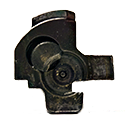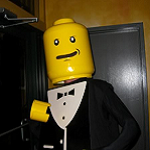|
MomJeans420 posted:I thought the same thing but that's a seal, so I think it has to be 7. I don't know why my brain is having so much trouble with that parts diagram this morning. Alternatively, whatever self locking nut you can get that threads on the end.
|
|
|
|

|
| # ? Apr 30, 2024 17:02 |
|
Finger Prince posted:Alternatively, whatever self locking nut you can get that threads on the end. Honestly this. Original parts are usually overpriced anyway.
|
|
|
|
M6x1.0 would be very easy to find, but if I'm reading the diagram correctly (and that's a big if for some reason today) the nut is left hand threaded. I think I'll buy a regular nut first to see if I'm wrong, if not I'll have to travel farther to find a place with LH nuts in stock.
|
|
|
|
In the actual picture of the threads you posted they're clearly right handed.
|
|
|
|
MomJeans420 posted:I thought the same thing but that's a seal, so I think it has to be 7. I don't know why my brain is having so much trouble with that parts diagram this morning. It's not 7. There is a leader line from the shift linkage going right through 7, showing that it's the nut on the adjustment arm at the bottom of your photo. That one is definitely left-handed as you can see from the threads. They have chosen an abysmal angle for the diagram in the parts fiche (British bike, who'd have thought) but this is how it's laid out:  It looks to me like there is a captive nut on the back of the pinch arm thing that connects to the shifter shaft. You are missing part 4, which I suspect is some sort of rubber gasket or boot, and the unmarked part after it is the loose ball joint/bolt thing in your photo. Feel around on the back of the arm and see if the ball joint threads directly into it. If what looks like a captive nut is just an unlabeled nylock nut or something, then I would say just pull out the ball part and take it to the hardware store and find a nylock that fits. This nut doesn't have to be a special grade of steel or anything. Sagebrush fucked around with this message at 00:29 on Feb 9, 2021 |
|
|
|
Also I would just like to post this, from the manual of my 1971 CL350. Usually when people say things were better in the old days they're talking out their rear end, but people were absolutely better at drafting in the old days. No question. what's isometrics, precious? who cares just print it out at whatever angle CATIA shows it, what's the difference
|
|
|
|
Hand drafting is a drat art, killed unceremoniously by CAD, 99% for good reasons, except the above mentioned one
|
|
|
|
MomJeans420 posted:I thought the same thing but that's a seal, so I think it has to be 7. I don't know why my brain is having so much trouble with that parts diagram this morning. 
|
|
|
|
Now would be a good time to mention that Triumph are the only brand I've ever seen where the ball part is actually removable from the cup part, there is a small wire loop (#5 and visible in the photo as well) that you slide then rotate out of the way. It will NOT stay in there without that piece and people wreck them constantly. The missing piece is just a totally normal 6x1 10mm nut with a flare base. Source: staring at a street triple rn
|
|
|
|
|
momjeans420 I have a M6 nylock nut I will mail to you right now if you want
|
|
|
|
Red loctite it. Be the PO
|
|
|
|
Sagebrush posted:momjeans420 I have a M6 nylock nut I will mail to you right now if you want Thanks, I wish I had seen your post and this one: Renaissance Robot posted:In the actual picture of the threads you posted they're clearly right handed. Before I went out a bunch a couple of variations of M6x1.0 nuts from the hardware store, then ordered two left hand thread nuts from Fastenal ($1.40 in parts, $9 shipping). After all that, the part on the ball joint just screws in and there's no nut on the other side. It seems odd because the threading doesn't start until you get pretty far back in there, so it seemed like something that would have required a nut, but once it's screwed in all the way there isn't any thread sticking out. I guess that explains my problem with the parts diagram - I thought 4 had to be the right spot, but having it labeled as a seal rather than a nut threw me off. But also, this really is a much better diagram: Jim Silly-Balls posted:Red loctite it. Be the PO I used copious amounts of red loctite then followed it up with large amounts of silicone sealant, just in case
|
|
|
|
Don't forget to weld it on too
|
|
|
|
real pros use the free loctite: crossthreading
|
|
|
|
right arm posted:real pros use the most powerful loctite: hot riveting
|
|
|
|
MomJeans420 posted:After all that, the part on the ball joint just screws in and there's no nut on the other side. It seems odd because the threading doesn't start until you get pretty far back in there, so it seemed like something that would have required a nut, but once it's screwed in all the way there isn't any thread sticking out. So the diagram was actually totally correct, and there is a captive nut/threaded bit on the back of that pinch bolt arm just as depicted  Parts fiche drawings are often lovely but I don't think I've yet encountered one that is outright wrong.
|
|
|
|
Even if the bolt threads into that arm, put a bit on it anyway. Unless you really did loctite it
|
|
|
|
I just screwed it in to make sure it worked, but I was going to take it off this weekend to clean + grease it so I didn't worry about it too much. Although blue loctite is probably a good idea, maybe even purple as it's a pain to get a lot of force on this part, but I have blue lying around and I think it will be fine.
|
|
|
|
Quick question -- the front of my bike (I think), 2003 F650GS, has now started to wobble at relatively low speeds. This is somewhat unsettling to me and nothing's changed except it being cold recently. I'm checking up on the F650GS FAQ site, but what are the usual areas to examine / check for torque / tightness? Bearings (wheel, steering) come to mind, examining the tire(s) for any damage / under-inflation seems logical... what else should I generally look at?
|
|
|
|
Tyre pressure and condition (check the rear too), wheel bearing, steering head bearings (front wheel free and off the ground, check that they smoothly travel lock to lock and there's no play if you grab the axle and try to move the wheel front-rear), fork seals for leakage.
|
|
|
|
|
Slavvy posted:Tyre pressure and condition (check the rear too), wheel bearing, steering head bearings (front wheel free and off the ground, check that they smoothly travel lock to lock and there's no play if you grab the axle and try to move the wheel front-rear), fork seals for leakage. Roger -- thanks! Sounds like a plan for tomorrow.
|
|
|
|
Speaking of steering head bearings, I need to replace mine and the OEM are ball bearing while the aftermarket are tapered. From what I've heard, the OEM are trickier to install but a lot of people seem to think they're "better" than tapered bearings, which are less sensitive to proper torque or whatever the issue is. I'm going to go with OEM unless there's no issue at all with the aftermarket ones? Also, lol at this: 
|
|
|
|
Taper roller bearings take nominally more force than balls to get moving so a certain type of person thinks they have better steering feel or whatever. Taper rollers are better in every single way, they need less adjustment and greasing and they don't degrade as quickly, and they're easier to fit. The only problem is sometimes the manufacturer thinks tapers will fit on a roller bike based on the dimensions but they don't account for triple clamp and frame design, I've never encountered this on a japanese bike though.
|
|
|
|
|
This is for my Daytona but I'm guessing it's similar to the Japanese bikes. I know people on the Daytona forums have used the tapered bearings without issue. I honestly can't imagine I'd feel the difference in force to turn in considering that it's pretty much zero force right now.
|
|
|
|
Oh. Funnily enough the most frequent problem combination for me is street triple + all balls taper bearings. The dimensions etc are all correct but they simply don't account for the shape of the frame so you end up with the frame bottoming out on the lower triple. So now with triumphs I go straight to genuine, grit my teeth and bear the balls.
|
|
|
|
|
Slavvy posted:Tyre pressure and condition (check the rear too), wheel bearing, steering head bearings (front wheel free and off the ground, check that they smoothly travel lock to lock and there's no play if you grab the axle and try to move the wheel front-rear), fork seals for leakage. I am a dumb (read: lazy) motherfucker and my tires were badly underinflated. I could see the front not even quite sitting correctly on the rim. Inflated both front / rear back up to 36 psi and even just going around my driveway / standing still, the front turns so much easier.
|
|
|
movax posted:I am a dumb (read: lazy) motherfucker and my tires were badly underinflated. I could see the front not even quite sitting correctly on the rim. Inflated both front / rear back up to 36 psi and even just going around my driveway / standing still, the front turns so much easier. Congrats you need new tires.
|
|
|
|
|
Yup. If your bike has been squirrelly for a while, ie you’ve been running significantly lower pressure than you should for a while, you’ve hosed your tyres up somewhat by running them under-inflated. How much, I dunno. I check the pressure and maintain the right pressure often on mine.
|
|
|
|
Sigh -- was planning on getting some soon anyways.... Annakee IIIs or TKC 80s?
|
|
|
|
TKC80s, the Anakees were unimpressive everywhere except tread life and they're noisy to boot
|
|
|
|
Steakandchips posted:Yup. If your bike has been squirrelly for a while, ie you’ve been running significantly lower pressure than you should for a while, you’ve hosed your tyres up somewhat by running them under-inflated. Wait, what?
|
|
|
|
Slavvy posted:Taper roller bearings take nominally more force than balls to get moving so a certain type of person thinks they have better steering feel or whatever. I haven't seen it before or since but my Buell used sealed wheel bearing style bearings for the steering head. Somehow they went bad within 15k kilometers.
|
|
|
|
High Protein posted:I haven't seen it before or since but my Buell used sealed wheel bearing style bearings for the steering head. Somehow they went bad within 15k kilometers. That's weird. Were the bearings pressed into the steering head?
|
|
|
|
Looking at getting some new springs and they're asking for my rider weight; do I quote my actual weight or add a few kilos to account for the gear I'll be wearing and stuff I always carry like cargo rack etc? The stock rate seems fine to me, I've never bottomed out even with a pillion, but I don't know what that rate actually is. Renaissance Robot fucked around with this message at 14:03 on Feb 21, 2021 |
|
|
|
I believe racetech at least asks for all-up weight (rider+gear)
|
|
|
|
High Protein posted:I haven't seen it before or since but my Buell used sealed wheel bearing style bearings for the steering head. Somehow they went bad within 15k kilometers. The original rear wheel bearing on a Buell I owned disintegrated after 5k original miles.
|
|
|
|
Renaissance Robot posted:Looking at getting some new springs and they're asking for my rider weight; do I quote my actual weight or add a few kilos to account for the gear I'll be wearing and stuff I always carry like cargo rack etc? do you ride in the nude? if not, then give them your weight + 10-15lbs for gear
|
|
|
|
movax posted:Sigh -- was planning on getting some soon anyways.... Annakee IIIs or TKC 80s? those are two very different styles of tires. what riding you doing? what bike you riding? if it's something heavy (adventure) I'd recommend staying away from the TKC80s as they have the weakest sidewalls out there if you plan on riding fast on rocky poo poo, but they're pretty great besides the weak sidewalls and terrible longevity (I killed mine in around 1000mi, but that was quite a bit of street, wheelies, and new bike excitement)
|
|
|
|
Horse Clocks posted:Wait, what? Running your tires significantly under-inflated causes the sidewall to deform much more than it's supposed to, which creates heat localized to that part of the tire, and the combination of flexing and heat damages the rubber over time. Kind of like bending a paperclip back and forth until it snaps from fatigue, although of course rubber is much more resilient than steel. If you look around the perimeter of the damaged tire you'll see a band of little wrinkles. The weakened tire could blow out unexpectedly. It's not a guaranteed instant failure or anything, but because motorcycle tires are so critical it's not really worth taking the risk.
|
|
|
|

|
| # ? Apr 30, 2024 17:02 |
|
Does that still apply if you're running inner tubes?
|
|
|























